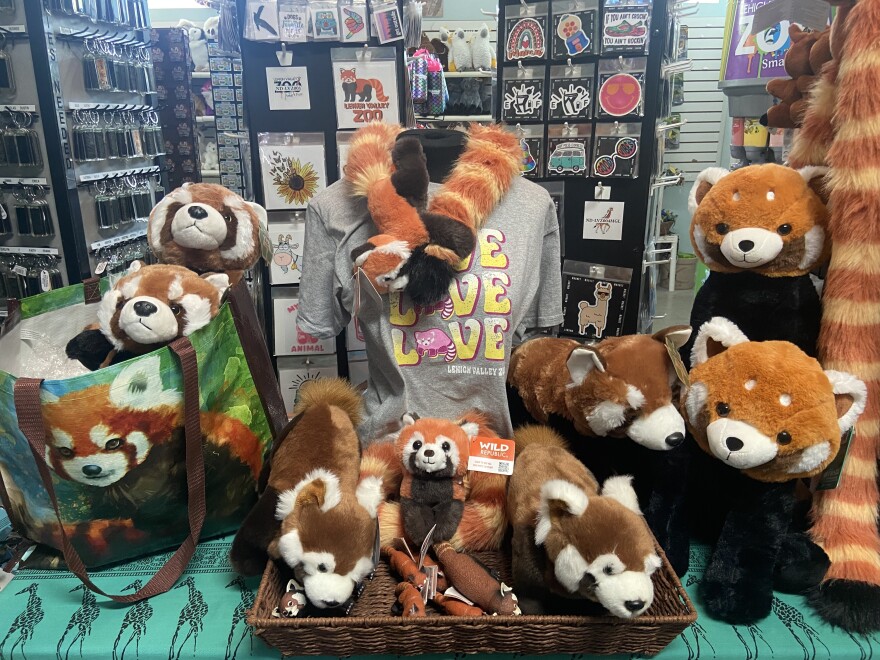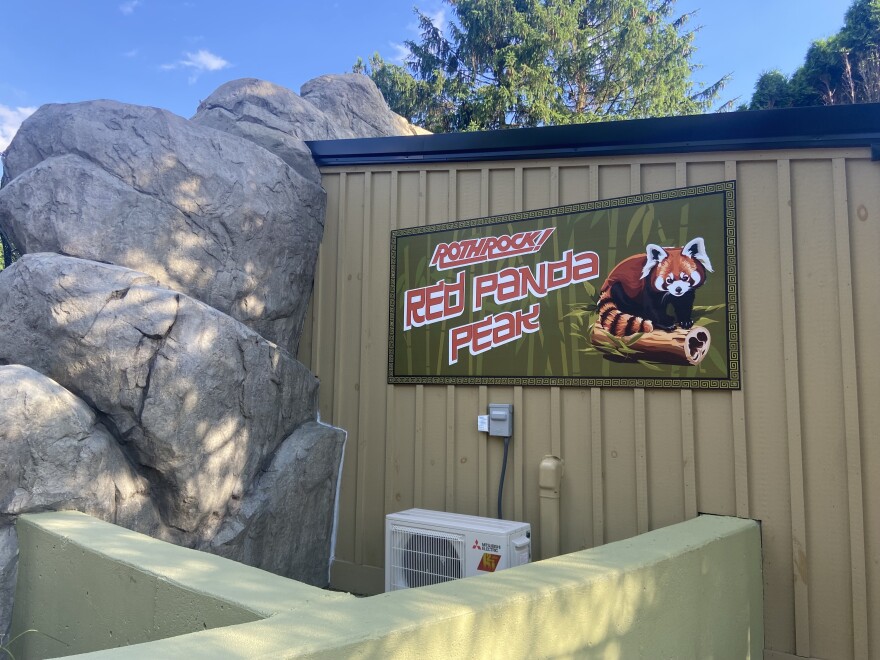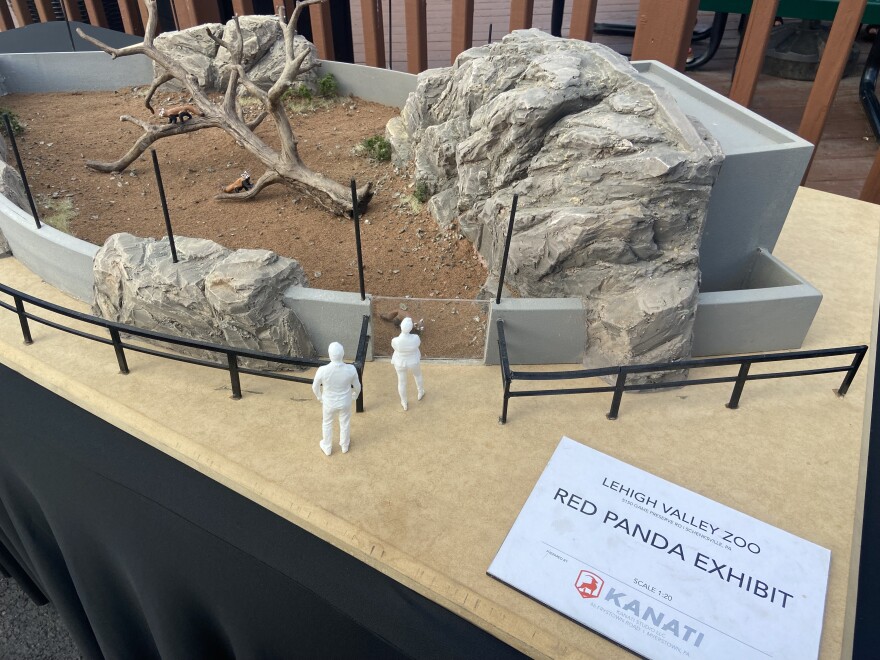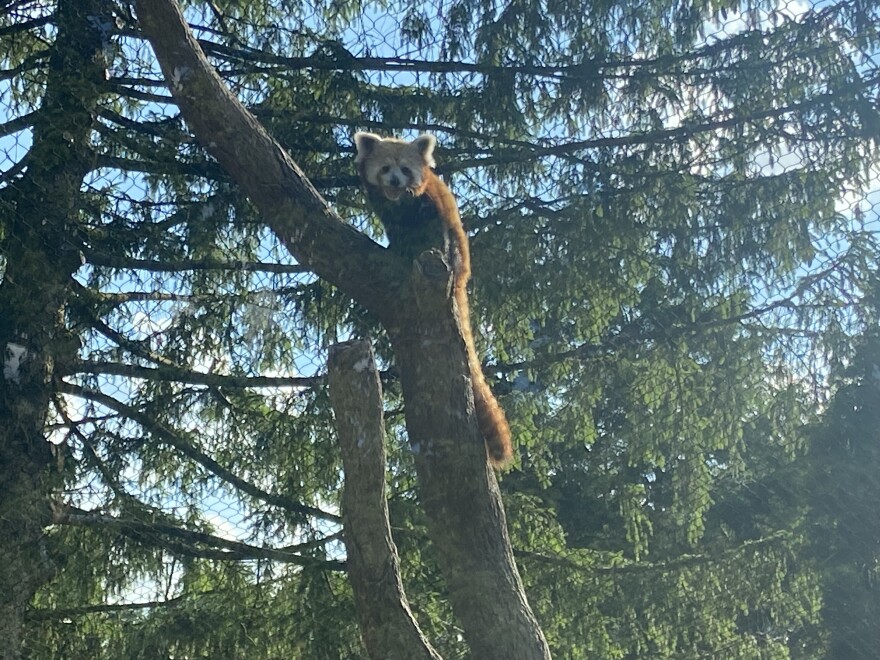NORTH WHITEHALL TWP., Pa. — Two red pandas basked in the sun Thursday evening, cuddled together as water misted from the bamboo platform beneath them.
Less than a week after their first birthday, the brothers, Cosmo and Meeko, drew a crowd of dozens to their new home at Lehigh Valley Zoo.
Visitors took pictures, smiled and pointed as the small, rusty-coated animals lazed in the sun, or scurried across a branch to graze.
While it was impossible to tell with an untrained eye, staff said that both are adjusting well, but Cosmo is very outgoing and curious while Meeko is a bit shyer and more reserved.
“Our goal is to educate our guests here at the zoo about the importance of this species in the wild and any of the steps that we can do here to help protect them."Amanda Shurr, president and CEO of Lehigh Valley Zoo
“Red pandas are the first of several Asian species we hope to add here at the zoo as we move forward with our plans to build a Himalayan Highlands,” Zoo Chief Executive Officer Amanda Shurr said.
“This new habitat will help us further our mission to connect our community with nature. To help empower all of you to protect wildlife.”
Staff, volunteers and donors gathered at the zoo, 5150 Game Preserve Road in Schnecksville, for a ribbon-cutting to mark the opening of Rothrock Red Panda Peak, a year-round exhibit.
Open to the public Friday, the habitat will help not only education efforts, but also raise awareness for endangered and threatened species, officials said.
“Our goal is to educate our guests here at the zoo about the importance of this species in the wild and any of the steps that we can do here to help protect them,” Shurr said.
“The work we do with this species, along with many other [Association of Zoos and Aquariums]-accredited institutions across the country is critical to their long-term survival.”
.@LVZoo’s newest exhibit, Rothrock Red Panda Peak, is officially open!
— Molly Bilinski, artisanal sentence crafter (@MollyBilinski) June 7, 2024
Keep an eye out for the story at @LVNewsdotcom 👀👀 pic.twitter.com/yIIDPjRmEF
Temperature-hardy and trendy
There are three main reasons why the zoo decided to bring in red pandas, Chief Operating Officer Matthew Provence said.
“First and foremost, it's a temperature-hardy creature; it's good for our environment in Schnecksville,” Provence said. “The second part is, this is our first Asian animal.
"As part of our 10-year master plan, we wish to extend into Asian animals into a section of our zoo. So the red pandas would be the forerunner of this part of our master plan.
“And third, which is the least of the priorities, the red panda is a very popular, trendy animal right now. It's exciting for our guests. It's exciting for the community. It's exciting for us.”

The popularity of red pandas has increased in the past few years following the release of the Disney and Pixar animated film “Turning Red.”
The animated film centers around a 13-year-old girl who transforms into a giant red panda.
Slightly larger than a house cat, but with a bear-like body, red pandas are predominantly tree-dwelling, according to the World Wide Fund for Nature, or WWF.
With fewer than 10,000 individual red pandas left in the wild, the agency has marked them endangered.
“Almost 50 percent of the red panda’s habitat is in the Eastern Himalayas,” according to WWF’s website.
“The loss of nesting trees and bamboo is causing a decline in red panda populations across much of their range because their forest home is being cleared.”
'Positively impact red pandas'
In addition to habitat loss, red pandas also are threatened by poaching, as well as being caught in traps meant for other animals.
Similar to the two red ruffed lemurs and three African penguins that recently joined the zoo — in different habitats, of course — the red pandas are part of a species survival plan that helps to manage and conserve threatened or endangered species populations.
By bringing in Cosmo and Meeko from Alabama’s Birmingham Zoo, Lehigh Valley Zoo is playing “a key role” in a new five-year program designed for red panda conservation, officials said.
“The AZA, the zoo’s accrediting body, recently added red pandas to its Saving Animals From Extinction program, which uses the collective expertise within AZA-accredited zoos and aquariums and leverages their massive audiences to save endangered species in their natural habitat,” zoo officials said previously.
“With the importance of local communities to red panda conservation, L.V. Zoo’s inclusion in this SAFE program can positively impact red pandas around the world.”

As part of the program, the zoo will support the Red Panda Network, a Nepal-based conservation organization “that works directly with local communities, empowering the people who live alongside red pandas to secure sustainable livelihoods and live harmoniously with local wildlife,” officials said.
‘Escape artists’
The exhibit, on the space that once housed the zoo’s North American prairie dogs, has been retrofitted and reconstructed to meet the needs of its new residents.
A large artificial tree, situated in the middle of the exhibit, will let Cosmo and Meeko climb and explore. There also are rocks for the pair to investigate and a little hut for shade.
“One thing that is important in the zoo world is that it’s all about maximizing the animal's welfare — they get what we call enrichment,” Provence said.
“And part of enrichment is being able to explore, climb, crawl — do the things they will do in the wild.”
And “netting is huge,” he said.
“From what I understand, red pandas are a bit of escape artists. So you have to have the proper amount of netting.Matthew Provence, chief operating officer of Lehigh Valley Zoo
“From what I understand, red pandas are a bit of escape artists,” he said. “So you have to have the proper amount of netting.
“And, at the same time, you don't want to be obtrusive to viewing the red pandas. And so, the state-of-the-art netting that you can see through well, but that fits all the requirements to kind of enclose the habitat and keep them safe.”
There’s also an indoor component, with heat to keep them warm in the winter and air-conditioning to keep them cool in the summer when they aren’t on exhibit.

“We created a habitat that is designed to provide the red pandas with the best home possible, meeting all of their welfare and well-being needs” Shurr said.
“The habitat is also pretty modern … with rock work, mesh netting and glass viewing windows to give all of our guests the optimum viewing experience at this habitat.
“We also thought a lot about the future when building this space, so we definitely have space for more red pandas, maybe, or even other species.”
Second new exhibit in two years
The new habitat came together quickly, in less than a year, after the zoo raised just shy of its $350,000 fundraising goal.
“We're about $5,000 away, which is awesome, because there’s still some money trickling in and we should be able to get there,” he said.
“A large reason why the exhibit takes on the Rothrock name is that the family: David, Patrina and Kian, came to really help us escalate the needs to complete construction.
“It was really good timing, and a very generous gift.”
Rothrock Red Panda Peak is the zoo’s second new exhibit in as many years.
In May 2023, officials opened Habitat Madagascar, a $1.2 million year-round lemur and tortoise exhibit.
Two red ruffed lemurs, Weasley and Makira, from Omaha’s Henry Doorly Zoo and Aquarium and the Bronx Zoo, respectively, have made it their home.
Red ruffed lemurs, which have a rusty red coat with black foreheads, bellies and tails, are native to Madagascar and are critically endangered.
It marked the first new exhibit for the zoo since 2017, when officials opened the Masai giraffe habitat.
The zoo opens 9 a.m. Friday for members only and to all other guests at 10 a.m. Tickets can be purchased at lvzoo.org.


